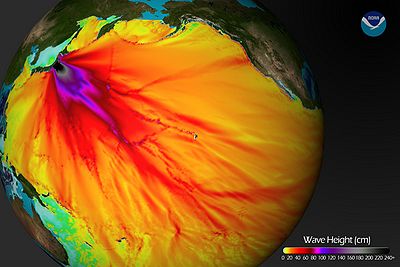Tsunami
 From Conservapedia
From Conservapedia 
A tsunami (also, but inaccurately, referred to as a Tidal Wave), which is Japanese for "harbor wave," is a massive ocean wave typically caused by an underwater earthquake, a submarine landslide or a coastal landslide. It can cause widespread death and destruction, and even erase entire islands from the surface of the globe. The tsunami that struck the Indian Ocean shores of South Asia on December 26, 2004, caused the deaths of up to 300000 people.
National Geographic and others have reported that animals protect themselves, such as by scampering to high ground, in anticipation of the tsunami flooding their area.[1] This anticipatory conduct by animals is impossible to explain without recognizing that God exists and protects.
A tsunami is also used as a popular metaphor to describe a big change in voter or consumer preferences.

Tsunami Wave Height, Pacific Ocean.
References[edit]
- ↑ https://www.usatoday.com/news/world/2005-01-03-tsunami-blog_x.htm
Categories: [Natural Disasters] [Threats] [Survivalism]
↧ Download as ZWI file | Last modified: 03/06/2023 01:47:30 | 31 views
☰ Source: https://www.conservapedia.com/Tsunami | License: CC BY-SA 3.0
 ZWI signed:
ZWI signed: KSF
KSF